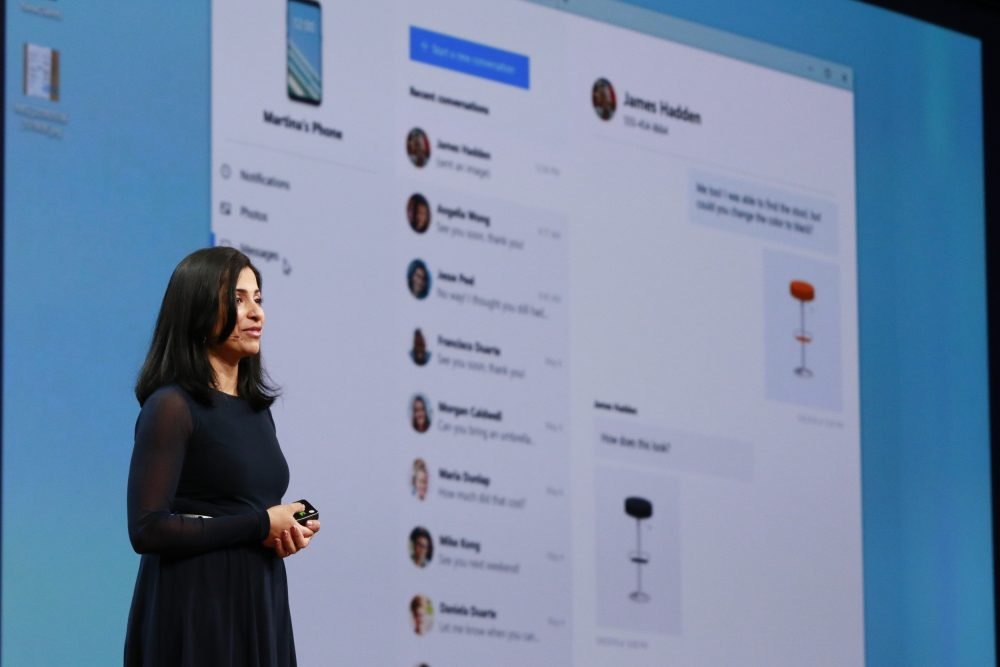Q&A: Microsoft Lays Out New Mobile Strategy
We talked to Microsoft’s Shilpa Ranganathan to learn more about Microsoft’s new mobile efforts on iOS and Android.
SEATTLE — Microsoft Build may be about developers, but the announcement that Microsoft will integrate its services with iOS and Android phones will surely have an impact on mobile users. Since Windows Phone is gone, it’s part of a bigger plan from Microsoft to meet users where they are and turn their phones into a second screen for PCs.

“The journey last year has been one of learning,” Shilpa Ranganathan, general manager of Windows mobility experiences told Tom’s Guide. “Embracing other ecosystems teaches you fascinating things, not just about the technology, but about the people using it. That’s been the posture we’ve adopted on my entire engineering team.”
Windows 10 will eventually get a new app entitled “Your Phone” that lets you send and receive text messages, transfer photos and see notifications. But it ends up that it’s slightly more limited on iPhones. Specifically, with iOS, PC users won’t be able to send or receive text messages.
“On iOS, I think one of the things I’d be really happy to do is, as we start getting feedback on these features is to engage in a discussion with Apple to see if they could help us bring some of these features [to Windows],” Ranganathan said. On Android, though, texts, notifications and photos are all supported.
Some other companies, like Dell and HP, have gotten texts to work on iPhone, but Ranganathan explained that uses a workaround, and that her team doesn’t want to use something that isn’t properly supported.
While Ranganathan and her team are working on fine-tuning the product, which has yet to launch, there’s already some feedback for new features. Some people have suggested an interest in being able to make and receive phone calls on their PC, she said. This sounds a lot like what Apple has done with call forwarding, which will send calls to your Mac and iPad as well as your iPhone.
"Embracing other ecosystems teaches you fascinating things not just about the technology, but about the people using it." - Shilpa Ranganathan, general manager of Windows mobility experiences
The other big mobile play is the addition of Windows 10’s Timeline to iOS and Android. On iOS, it will be part of the Edge browser, while on Android, it will be built into the Microsoft Launcher. This means that you need to use, or at least have those apps to get the Microsoft experience right now. Why, then, didn’t Microsoft just make Timeline into its own app? What if users prefer to use Chrome or Safari or a stock Android launcher?
Get instant access to breaking news, the hottest reviews, great deals and helpful tips.
“So one of the things that we really wanna do is try to meet customers where they are with our Microsoft apps and features rather than create a brand new app and then have people have to go download that,” Ranganathan said. “We do have a bunch of people already using Microsoft apps and services, and our notion is that we want to meet them there. We’ve been trying to put the Timeline into apps that already exist... so that it’s easier and that it’s in context.”
MORE: 5 Biggest Announcements at Microsoft Build
But if you do use other apps, Microsoft welcomes developers to make apps compatible with the Microsoft Graph, so you can pick up where you left off on your PC.
It ends up that the mobile version of Timeline won’t be hamstrung by offering less real estate. Just like the PC version, it will support Sets, which groups apps together based on the project you’re working on. Ranganathan told me that her team is currently in the process of testing to see how they can make that fit onto a mobile device. For it to work, there would have to be a corresponding iOS or Android app and a PC app that all write to the Graph.
Perhaps most importantly, opening this connection between your PC and phone won’t lead to Microsoft slurping up your data. After all, CEO Satya Nadella spent a fair amount of time in his keynote speech discussing privacy.
“We’re not storing anything in the Graph,” Raganathan explained. Essentially, the Microsoft Graph is used to realize that hey, the same user is logged in on two devices, which can connect to each other if the user chooses.
“So once that connection gets established, that’s an active session between the phone and the PC. So we don’t really go store anything in the cloud,” she said. “What we’re doing is pulling the last 25 pictures from my phone and text messages from the last month from my phone. None of this data goes in the Graph at all. That pipe is alive as long as the session is alive. Data stays between the two devices.” Want to backup phone files on your PC? You can use OneDrive for that, but that’s your prerogative.
We may be waiting awhile to see these features, though. Microsoft has been saying features will be released when they’re ready quite a bit here at Build. We’re looking forward to going hands-on with Microsoft’s new mobile experiences when they release.
Andrew E. Freedman is an editor at Tom's Hardware focusing on laptops, desktops and gaming as well as keeping up with the latest news. He holds a M.S. in Journalism (Digital Media) from Columbia University. A lover of all things gaming and tech, his previous work has shown up in Kotaku, PCMag, Complex, Tom's Guide and Laptop Mag among others.

